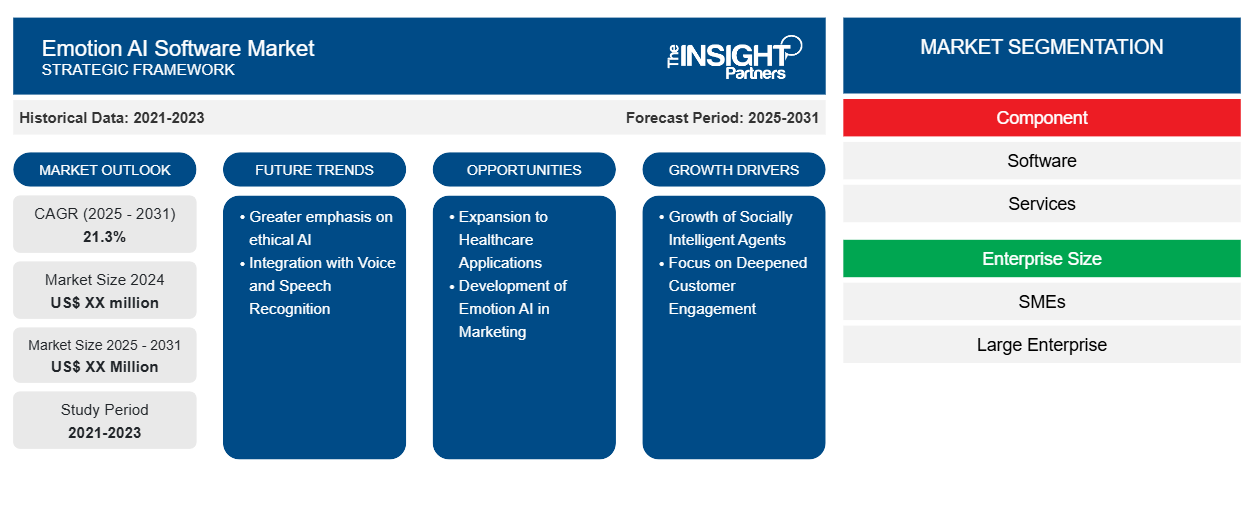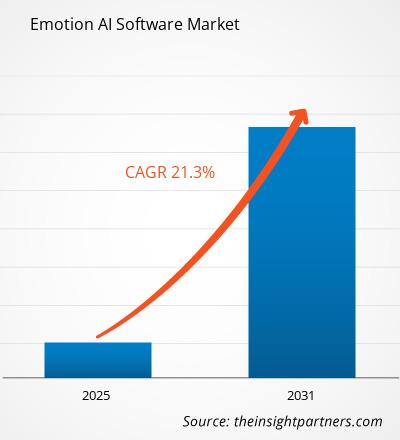The Emotion AI Software Market is expected to register a CAGR of 21.3% from 2025 to 2031, with a market size expanding from US$ XX million in 2024 to US$ XX Million by 2031.
The report is segmented by Component (Software, Services); Enterprise Size (SMEs, Large Enterprise); End Use Industry (BFSI, Healthcare, IT and Telecom, Retail, Government, Others). The global analysis is further broken-down at regional level and major countries. The report offers the value in USD for the above analysis and segments
Purpose of the Report
The report Emotion AI Software Market by The Insight Partners aims to describe the present landscape and future growth, top driving factors, challenges, and opportunities. This will provide insights to various business stakeholders, such as:
- Technology Providers/Manufacturers: To understand the evolving market dynamics and know the potential growth opportunities, enabling them to make informed strategic decisions.
- Investors: To conduct a comprehensive trend analysis regarding the market growth rate, market financial projections, and opportunities that exist across the value chain.
- Regulatory bodies: To regulate policies and police activities in the market with the aim of minimizing abuse, preserving investor trust and confidence, and upholding the integrity and stability of the market.
Emotion AI Software Market Segmentation
Component
- Software
- Services
Enterprise Size
- SMEs
- Large Enterprise
End Use Industry
- BFSI
- Healthcare
- IT and Telecom
- Retail
- Government
- Others
Geography
- North America
- Europe
- Asia-Pacific
- South and Central America
- Middle East and Africa
You will get customization on any report - free of charge - including parts of this report, or country-level analysis, Excel Data pack, as well as avail great offers and discounts for start-ups & universities
Emotion AI Software Market: Strategic Insights

-
Get Top Key Market Trends of this report.This FREE sample will include data analysis, ranging from market trends to estimates and forecasts.
Emotion AI Software Market Growth Drivers
- Growing Demand for Personalized Customer Experiences: The increasing need for personalized interactions in customer service, retail, and marketing is a major driver of the Emotion AI software market. Emotion AI, which can analyze emotions through facial expressions, voice tone, and body language, helps businesses offer more tailored and empathetic experiences. This leads to improved customer satisfaction, loyalty, and engagement, thereby driving the adoption of emotion recognition software across industries.
- Advancements in Artificial Intelligence and Machine Learning: Technological advancements in AI and machine learning have significantly enhanced the capabilities of emotion AI software. These developments allow emotion recognition systems to be more accurate, real-time, and context-aware. The integration of deep learning algorithms enables better interpretation of emotional cues, making emotion AI applications more reliable and appealing across various sectors, such as healthcare, automotive, and entertainment.
Emotion AI Software Market Future Trends
- Integration with Voice and Speech Recognition Technologies: A key trend in the emotion AI software market is the integration of emotion detection with voice and speech recognition technologies. By analyzing tone, pitch, and speech patterns, emotion AI can determine a person’s emotional state during phone calls or virtual meetings. This integration is particularly valuable in customer service, sales, and healthcare, offering more responsive and empathetic communication experiences.
- Adoption in Mental Health and Therapy Applications: Emotion AI is increasingly being adopted in mental health and therapy applications. These tools help therapists and healthcare providers assess emotional states and mental well-being by analyzing facial expressions, speech patterns, and behavioral cues. With the growing need for accessible mental health services, emotion AI is providing innovative solutions for remote diagnosis, therapy, and emotional support, thus contributing to market growth.
Emotion AI Software Market Opportunities
- Expansion in Healthcare for Early Diagnosis: Emotion AI presents significant opportunities in healthcare, particularly for early diagnosis and monitoring of mental health conditions such as depression, anxiety, and autism spectrum disorders. By analyzing emotions and facial expressions, emotion AI software can help healthcare providers assess patients' emotional states, offering early detection and intervention. This could lead to better patient outcomes and personalized care, driving demand in the healthcare sector.
- Enhanced User Experiences in Gaming and Entertainment: Emotion AI software has growing potential in the gaming and entertainment industries, where it can be used to adapt content based on users' emotional reactions. By analyzing emotions during gameplay or movie watching, developers can personalize experiences, making them more immersive and engaging. This trend offers an opportunity to create dynamic content that responds to the audience’s emotional cues in real time.
Emotion AI Software Market Regional Insights
The regional trends and factors influencing the Emotion AI Software Market throughout the forecast period have been thoroughly explained by the analysts at The Insight Partners. This section also discusses Emotion AI Software Market segments and geography across North America, Europe, Asia Pacific, Middle East and Africa, and South and Central America.
Emotion AI Software Market Report Scope
| Report Attribute | Details |
|---|---|
| Market size in 2024 | US$ XX million |
| Market Size by 2031 | US$ XX Million |
| Global CAGR (2025 - 2031) | 21.3% |
| Historical Data | 2021-2023 |
| Forecast period | 2025-2031 |
| Segments Covered |
By Component
|
| Regions and Countries Covered |
North America
|
| Market leaders and key company profiles |
|
Emotion AI Software Market Players Density: Understanding Its Impact on Business Dynamics
The Emotion AI Software Market is growing rapidly, driven by increasing end-user demand due to factors such as evolving consumer preferences, technological advancements, and greater awareness of the product's benefits. As demand rises, businesses are expanding their offerings, innovating to meet consumer needs, and capitalizing on emerging trends, which further fuels market growth.

- Get the Emotion AI Software Market top key players overview
Key Selling Points
- Comprehensive Coverage: The report comprehensively covers the analysis of products, services, types, and end users of the Emotion AI Software Market, providing a holistic landscape.
- Expert Analysis: The report is compiled based on the in-depth understanding of industry experts and analysts.
- Up-to-date Information: The report assures business relevance due to its coverage of recent information and data trends.
- Customization Options: This report can be customized to cater to specific client requirements and suit the business strategies aptly.
The research report on the Emotion AI Software Market can, therefore, help spearhead the trail of decoding and understanding the industry scenario and growth prospects. Although there can be a few valid concerns, the overall benefits of this report tend to outweigh the disadvantages.
Frequently Asked Questions
What are the options available for the customization of this report?
What are the driving factors impacting the global emotion AI software market?
What are the deliverable formats of the market report?
What are the future trends of the emotion AI software market?
What is the expected CAGR of the emotion AI software market
- Historical Analysis (2 Years), Base Year, Forecast (7 Years) with CAGR
- PEST and SWOT Analysis
- Market Size Value / Volume - Global, Regional, Country
- Industry and Competitive Landscape
- Excel Dataset
Recent Reports
Related Reports
Testimonials
Reason to Buy
- Informed Decision-Making
- Understanding Market Dynamics
- Competitive Analysis
- Identifying Emerging Markets
- Customer Insights
- Market Forecasts
- Risk Mitigation
- Boosting Operational Efficiency
- Strategic Planning
- Investment Justification
- Tracking Industry Innovations
- Aligning with Regulatory Trends





















 Get Free Sample For
Get Free Sample For